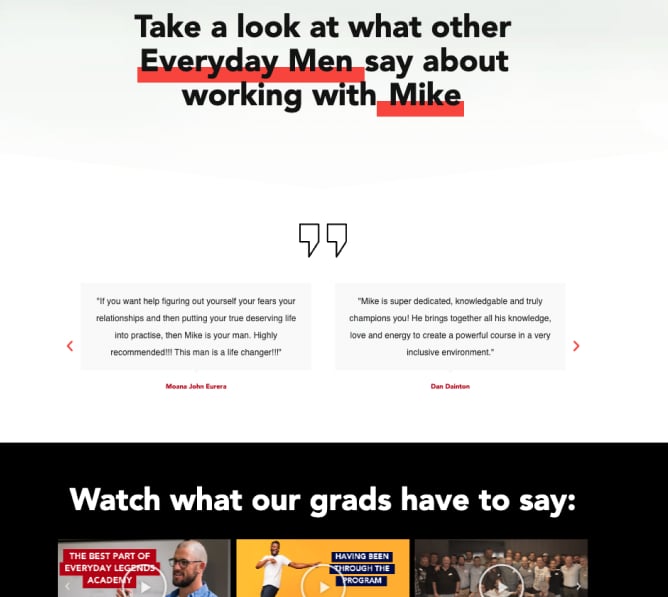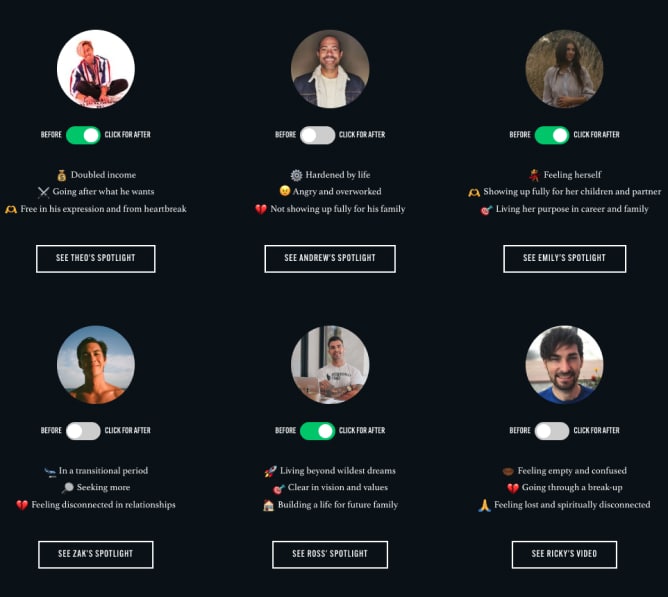Gathering and flaunting life coaching testimonials isn’t just about patting yourself on the back. It’s an art and a science, one that involves more than just collecting kind words. Think of it as your personal fan club, where each member’s rave review is a beacon of light guiding new clients your way. Let’s dive into the nifty tricks of acquiring and displaying these golden nuggets of praise, ensuring your life coaching business shines brighter than a disco ball at a 70s dance party.
Introduction to the World of Life Coaching Testimonials
So, you’re a life coach. You’ve helped people transform their lives, turning their dreams into reality, and now you’re sitting on a goldmine of positive feedback. But how do you leverage these life coaching testimonials to attract more clients? It’s simple: you showcase them! However, there’s a knack to doing this effectively. It’s not just about slapping them on your website and calling it a day. No, it’s about strategic placement, authenticity, and a touch of flair.
The Quest for Authentic Testimonials
First things first, let’s talk about gathering testimonials. The key here is authenticity. You want real stories from real people. How do you get them? Ask! After a coaching session, if you see that glint of satisfaction in a client’s eyes, that’s your cue. Politely ask if they’d be willing to share their experience. Most clients are more than happy to sing your praises, especially if they’ve seen significant changes in their lives. If you are uncomfortable with asking in person, an email with a prompt to leave a testimonial also works.
But here’s a twist: don’t just ask for a “testimonial.” Ask them to share their story. What challenges were they facing? How did the coaching help? What specific results did they see? Stories resonate more than generic “they’re great” statements. Plus, they’re way more fun to read!
Dive deeper with your questions. “What were the hurdles you faced when we began? How did our sessions guide you through these challenges? Can you pinpoint any milestones or significant shifts you’ve experienced?” It turns a simple feedback request into an opportunity for your clients to reflect on and celebrate their journey, making their stories not only more compelling to potential clients but also incredibly rewarding for them to share. After all, who doesn’t love a story that moves, inspires, and connects?
Life Coaching Testimonials Prompt Examples
When inviting your clients to share their journey for a testimonial, crafting your questions thoughtfully can make all the difference. Here are some examples of questions and prompts that can help elicit detailed, heartfelt stories:
- Before we started working together, what were the biggest challenges you were facing? This question helps clients reflect on their starting point and the obstacles they needed to overcome, setting the stage for a transformation story.
- How did our coaching sessions help you tackle these challenges? This prompts clients to think about the process and identify specific aspects of your coaching that were most beneficial to them.
- Can you share a moment or session that was a turning point for you? This question aims to capture those breakthrough moments that felt like a significant shift in their journey.
- What specific results or changes have you noticed in your life since starting our coaching? Here, you’re asking for tangible outcomes, which potential clients find very compelling.
- How do you feel about these changes? This encourages clients to express the emotional impact of their transformation, adding depth to their story.
- What would you say to someone considering coaching but isn’t sure yet? This question allows clients to offer advice based on their experience, indirectly endorsing your coaching services.
Enhanced Life Coaching Testimonial Collection Methods
Gathering authentic testimonials is a crucial step in showcasing the transformative impact of your life coaching services. Beyond the initial ask, there are strategic ways to encourage clients to share their stories, ensuring you capture a wide range of experiences and outcomes. Let’s dive into three effective approaches: personalized email campaigns, a structured follow-up strategy, and offering incentives for testimonial submission.
Utilizing Email Campaigns for Testimonial Collection
Crafting personalized email campaigns can significantly boost your testimonial collection efforts. This approach allows you to reach out to clients individually, acknowledging their unique journey with you and inviting them to share their story. Here’s how to make it work:
- Personalization is Key: Address clients by name and reference specific achievements or milestones they reached during their coaching with you. This personal touch makes the email feel exclusive and reminds them of their progress, making them more likely to share.
- Guiding the Narrative: Include prompts and questions in your email to help clients structure their testimonials. Ask them to reflect on where they started, the challenges they overcame, and the outcomes they’re proud of. This guidance helps clients provide detailed and meaningful testimonials.
- Simplify the Process: Provide a direct link in the email where they can submit their testimonial, whether it’s a simple form on your website or a reply email. The easier it is to respond, the more likely they will do it.
Implementing a Testimonial Follow-Up Strategy
Consistent follow-up is essential in ensuring clients share their testimonials. A gentle reminder can often be the nudge needed for them to take action. Here’s how to implement an effective follow-up strategy:
- Timing the Follow-Up: Wait a week or two after the initial request before sending a follow-up. This gives clients enough time to reflect but keeps the request fresh in their minds.
- Vary the Medium: If your initial request was via email, consider a different approach for the follow-up, such as a personal text message or a mention in a regular coaching session.
- Express Gratitude in Advance: Thank them for considering sharing their testimonial, reinforcing how valuable their story is to you and potential clients. This positive reinforcement can motivate them to share.
Offering Incentives for Testimonial Submission
While the intrinsic motivation to share a positive coaching experience can be strong, offering ethical incentives can further encourage clients to submit testimonials. Here’s how to approach this tactfully:
- Provide Value-Added Incentives: Offer something that complements their coaching experience, such as a discount on future sessions, exclusive access to workshops, or early access to new content. These incentives should feel like a natural extension of their growth journey, not a bribe.
- Make it Mutual: Frame the incentive as a token of appreciation for their time and effort in sharing their story. This maintains the integrity of the testimonial, ensuring it remains an authentic reflection of their experience.
- Communicate Clearly: Be transparent about what the incentive is and how they can claim it once they’ve submitted their testimonial. Clear communication prevents any misunderstanding and reinforces trust.
Creating the Perfect Testimonial Page
Now, you’ve got your testimonials, but where do you put them? Everywhere! Okay, not literally everywhere. That would be weird. But there are key spots where life coaching testimonials can make a huge impact:
1. Homepage: Your homepage is prime real estate. It’s often the first page visitors land on, so having a few powerful testimonials here can set the tone for what’s to come.
2. Services Page: Potential clients are checking out your services, wondering if you’re the right fit. Boom! Hit them with a testimonial from someone who’s achieved what they’re aiming for.
3. Dedicated Testimonial Page: This is where you can let loose. Fill this page with stories, pictures, and even videos of happy clients. Think of it as your own little hall of fame.
4. Sidebar or Footer: These areas are visible across your site, making them perfect for rotating testimonials. It’s like having a little cheerleader encouraging visitors as they browse.
How our Clients Showcase Testimonials

Mike Campbell
Mikes testimonial page seems straightforward at first, but the more you scroll, the more there is to discover. Simple testimonials transition to videos of happy clients, that transitions to a very personal and very “Mike” CTA. Overall, his testimonial page hits the basics, but also goes a lot deeper than that.

Rick William
Rick has gone all out with testimonials. This is very creative, showing interactive sliders that show the result that was achieved. When you click on the spotlights, you see an in-depth showcase of the client and how their goals were achieved. Creative, and deep. Full marks!

Preston Smiles
More basic, but also touching. Preston stands among praise and happy clients. The varied and authentic testimonials are neatly organized, providing quick snippets that highlight diverse and transformative experiences, reflecting the broad impact of the coaching services.
The Magic of Video Testimonials
In a world where everyone’s glued to their screens, video testimonials are like gold. They’re personal, engaging, and let potential clients see the emotion behind the words. Encourage willing clients to record a short video sharing their experience. It doesn’t have to be Hollywood quality; authenticity wins the race here. A simple smartphone video can do wonders.
Leveraging Social Proof Beyond Your Website
Your website serves as your home base, but the world of social media offers a vast frontier for showcasing life coaching testimonials. Each platform has its unique audience and best practices:
- LinkedIn: Ideal for professional testimonials, LinkedIn allows you to connect with a network of professionals who might value the transformational stories of your clients. Consider writing articles or posts that highlight a client’s journey, embedding their testimonials within a narrative that showcases their growth and your role in their journey.
- Instagram: A visual platform perfect for sharing quotes and video testimonials. Use stories and highlights to create a permanent archive of testimonials. Consider creating a specific testimonial template for your posts to maintain brand consistency. IGTV and Reels offer creative formats for longer and more engaging testimonial stories.
- Facebook: With its broad demographic reach, Facebook is great for sharing detailed testimonials. Create dedicated posts for each testimonial, and consider using Facebook Live to host Q&A sessions with past clients willing to share their experiences in real-time.
- Twitter: Ideal for short, impactful quotes from testimonials. Use Twitter threads to tell more detailed success stories, breaking down the client’s journey into engaging snippets.
Getting Creative with Testimonial Presentation: Beyond the Basics
Testimonials don’t have to be static quotes on a webpage. Here are some innovative ways to present them:
- Infographics: Combine statistics with quotes to create a powerful visual story of your coaching impact. Infographics are highly shareable and can succinctly convey the value you bring to your clients.
- Testimonial Collages: Create a collage of client photos, quotes, and outcomes to share on social media or your website. This visual format can quickly convey diverse client success.
- Animated Testimonials: Use animation to bring testimonials to life. Simple animations that highlight key quotes or create a dynamic backdrop for video testimonials can capture attention and make the testimonial more memorable.
- Podcast Episodes: Invite clients to share their stories on your podcast. This long-form medium allows for a deep dive into their experiences, providing listeners with insights into the coaching process and outcomes.
Navigating the Challenges of Collecting Life Coaching Testimonials
While gathering testimonials is a powerful way to showcase the impact of your life coaching, it’s not without its hurdles. Recognizing and addressing these challenges head-on can demystify the process and provide valuable insights for overcoming them.
Challenge 1: Hesitation from Clients
Some clients may feel shy or uncertain about sharing their stories publicly. This hesitation can stem from privacy concerns or simply not knowing what to say.
Solution: Reassure clients about their control over the process. Let them know they can review and approve their testimonial before it goes live. Offering to anonymize their testimonials can also ease privacy worries. When asking for their story, provide clear guidance on what to include, making it easier for them to articulate their experiences.
Challenge 2: Collecting Detailed Testimonials
Another common challenge is receiving testimonials that are too vague or generic to be impactful. “They’re great!” is nice to hear, but it doesn’t convey the specific benefits of your coaching.
Solution: Guide your clients by asking targeted questions that prompt them to reflect on specific aspects of their journey and the outcomes they’ve achieved. Questions like, “What was a key takeaway from our sessions that you’ve applied in your life?” can elicit more detailed responses.
Challenge 3: Follow-Up Fatigue
Following up with clients for testimonials can sometimes feel like a chore, both for you and for them. There’s a fine line between gentle reminders and becoming a nuisance.
Solution: Establish a follow-up schedule that’s respectful of your clients’ time. A good practice is to send an initial thank-you note after a session, mentioning you’ll follow up about a testimonial. Then, wait a couple of weeks before sending a reminder. If they’re not responsive after a few attempts, it’s best to let it go graciously.
Challenge 4: Ensuring Authenticity
To help, some clients might offer testimonials that feel exaggerated or not entirely reflective of their true experience.
Solution: Emphasize the value of honesty and authenticity from the start. Let your clients know that their genuine feedback, whether it’s a mix of positive and constructive, is what resonates most with others. Authentic testimonials attract the right clients and contribute to your professional growth.
Challenge 5: Keeping Testimonials Fresh and Relevant
Over time, your coaching style and services may evolve, and testimonials that once perfectly captured the essence of your work might no longer do so.
Solution: Regularly review your collected testimonials to ensure they align with your current offerings. Encourage recent clients to share their experiences, and consider featuring a “testimonial of the month” to keep content dynamic and engaging.
The Dos and Don’ts of Testimonial Etiquette
While sharing testimonials is key to building credibility, it’s essential to approach this with the right etiquette:
- Do Personalize Your Requests for Testimonials: When asking for testimonials, personalize your request. Explain how their story can inspire others and express appreciation for their willingness to share.
- Don’t Use Testimonials Out of Context: Ensure that the testimonial accurately reflects the client’s intent and experience. Misrepresenting their words can damage trust and credibility.
- Do Offer to Anonymize Testimonials if Needed: Some clients may be happy to provide a testimonial but prefer to remain anonymous, especially if they’ve shared sensitive personal details. Respect their privacy and offer options for how they’re identified.
- Don’t Forget to Update Your Testimonials Regularly: Refresh your testimonials periodically to reflect your current coaching successes. This keeps your social proof relevant and dynamic.
- Do Engage with Comments on Social Media: When you share testimonials on social media, engage with any comments or questions. This interaction shows that you value feedback and helps to foster a community around your coaching services.
Conclusion: The Transformative Power of Life Coaching Testimonials
Life coaching testimonials are more than just words on a page. They’re proof of transformation, a beacon of hope for potential clients. By strategically gathering and showcasing these testimonials, you’re not just promoting your services; you’re building a community of success stories. So go ahead, spotlight those rave reviews, and watch as your life coaching business becomes a magnet for those seeking change.
Remember, in the grand scheme of things, it’s not just about attracting clients. It’s about building trust, credibility, and a brand that resonates with people’s aspirations. With a little creativity, authenticity, and strategic placement, your life coaching testimonials can become your most powerful marketing tool. Now, go forth and collect those stories like a seasoned treasure hunter. Your next testimonial could be the key to unlocking someone’s potential.
Your website isn’t the only place to show off those life coaching testimonials. Social media is your playground! Share testimonials on your platforms, tagging clients (with their permission, of course) to extend your reach. Platforms like LinkedIn are especially powerful for professional testimonials, adding that extra layer of credibility.
FAQ
What makes a good life coaching testimonial?
A good testimonial is authentic, detailed, and describes a client’s journey, challenges, and the specific outcomes achieved through coaching.
How do I ask for a life coaching testimonial?
Ask clients to share their story post-session, focusing on their transformation and the impact of the coaching process on their lives.
Can I incentivize clients for testimonials?
Yes, ethical incentives like session discounts or exclusive content can be offered as a token of appreciation for their time and feedback.
Where should I display life coaching testimonials?
Feature them on your website’s homepage, service page, and dedicated testimonial page, and share them on various social media platforms.
How often should I update my testimonials?
Regularly review and update your testimonials to ensure they stay relevant and reflect your evolving coaching services and client experiences.
